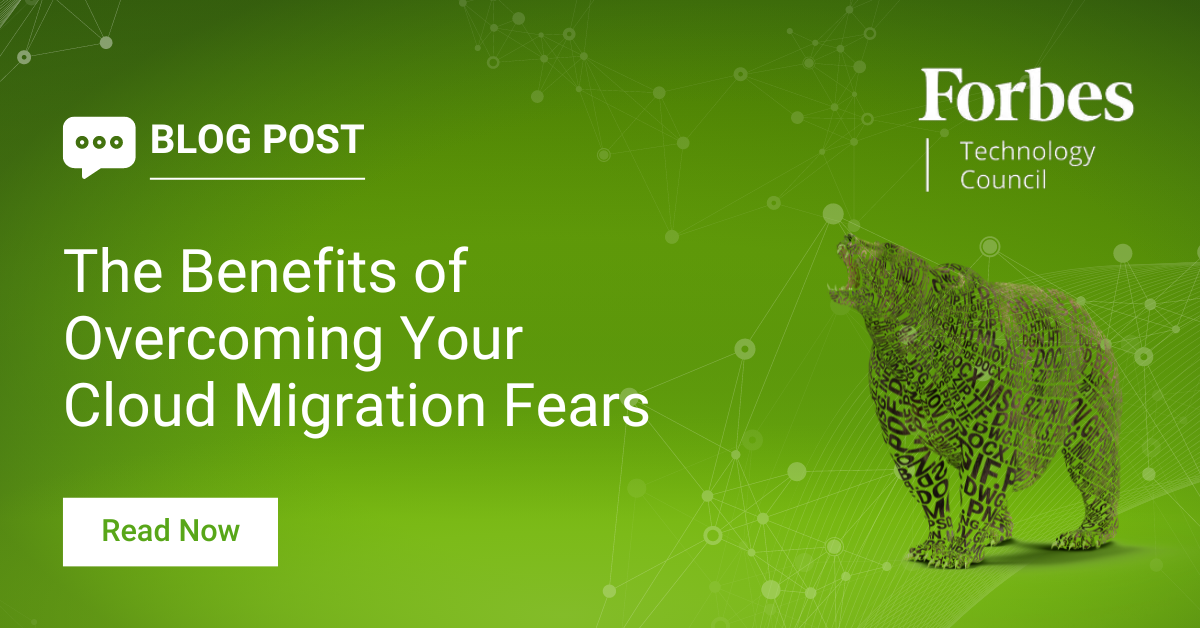The Benefits of Overcoming Your Cloud Migration Fears
January 24, 2024 | Russ Kennedy
Nobody likes to move. Thankfully, I haven’t had to pick up and switch homes for years. However, the memories of packing our belongings, transporting them from one place to another and then unpacking and arranging everything again aren’t entirely pleasant. Still, moving homes is nothing compared to the challenge of cloud migration.
I previously analyzed the common fears people experience when they start to look at migrating their organization’s data to the cloud. They’re worried about adopting new technologies, losing control of their data, experiencing extended downtime, missing project timelines and so much more. These fears are legitimate, especially if you dive right in and choose a solution without understanding your business objectives or deeply evaluating the underlying technology, the company behind it and the value it delivers to other customers in the market.
Data is one of the most important assets of any large enterprise today, and unstructured file data is especially critical. Manufacturing plants need their digital models. Architects and engineers need their 3-D plans. Media firms need the videos and images their clients depend on. Financial analysts can’t live without their spreadsheets. Healthcare providers cannot function without medical images.
It makes perfect sense that many organizations are initially hesitant to take the leap and move all of their data to the cloud. The best way to conquer your cloud migration fears is a thorough analysis of your options. I already shared some insights that help at the outset, but once you’ve addressed your initial hesitation, there are a few additional questions to consider.
Which cloud is right for you?
The three hyperscale clouds from Amazon, Google and Microsoft all have their strengths, but each one has subtle operational and financial differences that should be accounted for in advance. As you look at your cloud options, you want to build a deep understanding of the logistics involved as well as the different options for deployment and consumption.
Your data is not going to move to some ethereal storage medium. The cloud is an interconnected network of strategically situated physical infrastructure. You need to analyze exactly where in the world your data is going to reside, whether that region is right for you as well as your users and regulators, how your organization is going to consume those cloud resources and what these services will really cost.
How quickly will you be able to take advantage of all that the cloud has to offer?
The physics of moving data cannot be avoided. There is a time element to copying all of those bits and bytes from one place to another (and organizing them once they’ve been moved) for optimal use by your company. Yet you shouldn’t have to wait until your cloud migration is complete to start enjoying the benefits.
What you want to do is find a way to take advantage of as many of the tools as possible that your new infrastructure offers. There are methodologies today that can allow you to leverage your data while it’s being migrated, and you should consider this very seriously as you evaluate your options.
Are your users going to notice?
Typically, the IT team only hears from colleagues outside of its department when something goes wrong. Silence is bliss. Disruption is madness. Choose an architecture that allows the end users across your organization to continue working normally as you migrate their data to the cloud. Once your organization’s data is in the cloud, your users and applications need access to that data in a performant manner to get their jobs done. You should only consider solutions that provide secure, easy access to your data regardless of where your users reside.
Will you be prepared for what’s next?
Cloud migrations can be painless and efficient if done correctly, but what you really want to avoid is having to do it all over again in a short period of time. You don’t want to find yourself scouring the marketplace for an alternative in two years or going back to an antiquated solution you had in place previously. Make sure the cloud architecture you choose suits your needs today while also giving you the flexibility and optionality to easily scale as your needs grow and adjust your deployment to add new services in the future.
Those services will continue to improve. The hyperscale clouds are in a technological arms race to provide the best solutions. I know there is a great deal of AI hype out there and that it’s difficult to separate the interesting signals from the noise, but the intelligent cloud services space is one area that is undeniably exciting.
The potential is there to transform the way large organizations uncover insights about their operations and their business over the next decade. If your data is not in the cloud, you are going to miss out.
Learn how to confidently address cloud migration by reading Nasuni’s latest data sheet.
Bobby Silva shares Nasuni’s efforts to aid evolving global data sovereignty requirements and compliance regulations in addition to being recognized as a Google Cloud Assured Workloads partner.
Lance Shaw shares insight on how switching to hybrid cloud solutions can be positive for both the enterprise and the planet.
Andres Rodriguez shares why enterprises need to get fit for AI and the top factors prohibiting their AI success.


